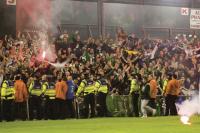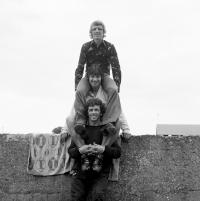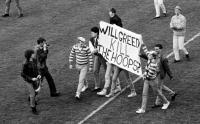Talking History: a history of Shamrock Rovers
Published in 18th–19th - Century History, 20th-century / Contemporary History, Issue 6 (Nov/Dec 2012), Reviews, Volume 20
Shamrock Rovers fans in high spirits away to Bohemians at Dalymount Park last season. (Paul Reynolds)
To say that Shamrock Rovers have had a disappointing season in 2012 would be an understatement. Having made Irish football history in 2011 by becoming our first club to reach the group stages of a major European competition, 2012 saw the club fail to take any silverware and crash to humiliating 5–1 and 4–0 defeats against Dublin rivals St Patrick’s Athletic and Bohemians. Undoubtedly it will be a year that many Hoops will want to forget. Yet, in the context of the history of Shamrock Rovers, it’s been far from a bad year. Recent years have brought stability to a club that spent over twenty years playing its home games in a variety of stadiums across Dublin after the loss of Glenmalure Park in 1987, a disastrous moment for both Shamrock Rovers and the domestic game.
Rovers, as Ireland’s most successful club historically, are certainly a worthy subject for Talking History to tackle. The panel consisted of Eunan O’Halpin of Trinity College Dublin, journalist John Byrne and club historian Eoghan Rice, all Rovers supporters. Mike Cronin of Boston College completed the panel.
Any discussion of the history of Shamrock Rovers must open with the issue of the club’s foundation. Today, Shamrock Rovers themselves claim 1901 as the year of the club’s establishment, though the gates of their historic home at Glenmalure Park claimed 1899. As Byrne noted early in the conversation, it’s known that the club joined the Leinster Junior League in 1901, but some maintain that the club was formed two years earlier and played a series of friendlies before joining the league. Whether founded in 1899 or 1901, this was a crucial period in the development of the game of soccer on the island of Ireland. Ireland’s oldest football club, Cliftonville FC, had been founded in Belfast in September 1879. The Irish Football Association (IFA), established in the following year, became the fourth-oldest national football association in the world (after England, Scotland and Wales). In Dublin, Bohemians FC had been founded in September 1890, while Shelbourne would follow in 1895. Both Shamrock Rovers and Shelbourne originated in the Ringsend district of the capital, though neither side play there today.

Eamon Dunphy, Ray Treacy and player-manager John Giles at a photo-call in Glenmalure Park on 10 August 1977, a period of ambitious plans for Rovers, including a 50,000 all-seater stadium. (Connolly Collection/SPORTSFILE)
Inevitably, the programme would end up looking at the broader questions of association football in Ireland. Mike Cronin looked at the influence of the revolutionary period on the game, noting that games between northern and southern teams were affected by the political climate of the period and that in many ways Irish association football was already partitioned before the creation of what is now the FAI in 1921. Shamrock Rovers won the first league title of the new association and, as Cronin noted, this instant success was important in building the club. Soccer in Dublin also had a vibrancy that was perhaps lacking in other parts of the country, as local rivalries developed.
Cronin observed that association football has been poorly treated by Irish historians: they have tended to focus rather on the Gaelic Athletic Association, with its connections to Irish nationalism. Nevertheless, recent years have seen some significant historical research on the game in Ireland, for example Neal Garnham’s Association football and society in pre-partition Ireland (Belfast, 2004), but it’s certainly true that soccer has received less attention from historians.
The influence of the British game on Irish attendances emerged on several occasions. Domestic league fans pinpoint the arrival of television coverage of English football in Ireland as a turning point for the game here, and it’s undeniable that the early 1970s marked a period of real decline. The decision of the club to appoint Johnny Giles as a player-manager in 1977 was an incredibly ambitious plan on the part of Rovers, perhaps an attempt to draw on the appeal of the English game to the Irish public by bringing in a figure of such repute. During this period the club had plans to construct an all-seater stadium for 50,000 spectators, and the arrival of Giles was to herald the dawning of a new era for the club. Giles was responsible for bringing players such as Paddy Mulligan and Eamon Dunphy into the field, yet, as Eunan O’Halpin correctly noted, whatever was happening at Rovers was not being replicated across the league, where standards remained low. Giles would resign in February 1983, and John Byrne’s quip that the whole situation had been a bit like Laurence Olivier joining his local drama club certainly raised a smile.

Will Greed Kill The Hoops?’—12 April 1987. Shamrock Rovers supporters and members of KRAM (Keep Rovers At Miltown) protest at Glenmalure Park after the final match (v. Sligo Rovers) played at the venue. (Ray McManus/SPORTSFILE)
The loss of Glenmalure Park in 1987 was devastating for the club, with the ‘Keep Rovers At Miltown’ campaign failing to prevent the Kilcoyne family from selling the ground to property developers. O’Halpin noted the demoralising nature of following a club with no home, and how the loss of the stadium was a real shock to the Rovers faithful, serving as ‘an example of a new Ireland, where property was becoming what mattered’. O’Halpin noted that Bohemians and Shelbourne in recent years have endured tough times as a result of deals falling through in relation to their grounds, believing that their homes were worth small fortunes in the Celtic Tiger days.
Towards the end of the programme Buzz O’Neill was introduced. O’Neill, club promoter at Rovers today, spoke of its being a fan-owned institution and that the club today is a testament to those who stood by it through so many years of uncertainty. This episode of Talking History was as much a study of the rise and decline of the beautiful game in Ireland as a study of one particular club. But will it encourage listeners to attend domestic football games, in a league in dire need of investment and support? HI
Donal Ó Falluin is co-editor of Dublin life and culture blog Come Here To Me, a ‘best of’ which has just been published by New Island Books.
















